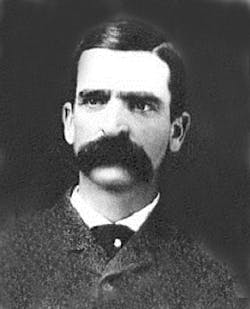For this month’s Legendary Lawman column we once again travel back to the turn of the 20th Century. Many of the lawmen of the time had… well, colorful pasts. Some even spent equal amounts of time on either side of the law. This is not the case with Marshal Seth Bullock. By all accounts his life was one of honor and distinction. Seth Bullock was born in Amherstburg, Ontario, Canada on July 23, 1847 to George Bullock, a retired British Major and his Scottish wife Agnes Findley. He had four siblings; three sisters (Agnes, Jessie and Alma) and a brother (couldn’t find his name). By his fifth birthday the family had relocated to Sandwich, Ontario as the Major had aspirations toward politics.
Apparently Seth’s relationship with his father was difficult as he ran away from home at the age of 16 and ended up in Montana living with his older sister for a time. She eventually would talk him into returning home but less than two years later, at the age of 18; he would once again leave home never to return. Sometime between 1867 and 1869 Seth ended up in Helena, Montana. The 1870 census lists a 22-year-old Seth Bullock as an “auctioneer”. Serving as a member of the Territorial Senate for two years (1871-1872) Bullock contributed to the introduction of the resolution that set aside Yellowstone as the first ever National Park.
Following his term in the Montana Territorial Senate, Bullock was elected Sheriff of Lewis and Clark County (1873). Not one to rest on his laurels, Bullock went into business with long time friend Solomon (Sol) Star, opening a hardware store. During his tenure as Sheriff he was wounded in the shoulder while attempting to apprehend Clell Watson. During the hanging of Watson a mob appeared and ran off the executioner (not sure why they would interfere with a perfectly good/legal hanging) and Bullock stepped in to pull the lever, sending Watson to his death. Watson is reportedly the first man to die at the hand of Seth Bullock.
1872 saw Bullock marry Martha Eccles, his childhood sweetheart, in Salt Lake City, Utah. Shortly thereafter he and Sol decided to embark on another business venture in Deadwood, South Dakota. Due to the unsavory element that inhabited Deadwood (miners, gamblers, gunfighters and prostitutes), Bullock thought it best to send his wife and newborn baby girl to Michigan to live with her family. Arriving in Deadwood on August 1, 1876 with a wagon train full of supplies, Bullock and Sol immediately set up a storefront in a tent.
The day following Bullock’s arrival in Deadwood marked the death of Wild Bill Hickock. Hickock was shot in the back of the head by one Jack McCall. Following a makeshift trial by a group of miners, McCall was found not guilty and fled the area. Bullock was appointed town Sheriff some weeks later. Some claim that Bullock was Deadwood’s first law, but it was actually Isaac Brown who was elected after the trial of Jack McCall on August 5, 1876. Brown’s tenure as town marshal was short lived however, as he was killed on August 20th with several other men while traveling between Deadwood and Crook City. Bullock was officially appointed Lawrence County Sheriff by Governor Pennington in March, 1877. He almost immediately appointed several deputies to assist him in “cleaning up” the town.
By all accounts Bullock never killed a man while serving as the Lawrence County Sheriff. In fact, his grandson claimed he could “outstare a mad cobra or a rogue elephant”. Many times he would look down an unruly miner and this would settle things down right quick. As the atmosphere in Deadwood became more friendly (and safer), Bullock brought his family out to join him. Given that he had more time on his hands he decided to try his luck in other areas. He and Sol purchased a spread of land at the divergence of Redwater Creek and the Belle Fourche River and began ranching and raising horses.
In early 1884 Bullock was appointed Deputy United States Marshal and while transporting Crazy Steve, a local horse thief, to Deadwood for trial he encountered Theodore Roosevelt. Deputy Sheriff Roosevelt was from Medora, North Dakota and the two shared stories over coffee and became fast friends. In the late 1880s Bullock granted the use of his land to the Fremont, Elkhorn and Missouri Valley Railroad free of charge. With the railroad being run through in 1890 Bullock founded the town of Belle Fourche, just three miles north of Minnesela. He and Sol offered free lots to anyone that moved a building from Minnesela to Bella Fourche. Apparently this worked pretty well as the town became the county seat. Belle Fourche also became the main shipping point for livestock; not just in the county or state but in the whole of the United States. This may have something to do with the farming of alfalfa in the area that was supposedly introduced by Seth Bullock.
Sadly, in 1894, Seth and Sol’s hardware store would burn to the ground (no notation on cause has been found). Bullock decided to build Deadwood’s first hotel in its place. This three-story, 64 room hotel cost $40,000 and has a steam heating system and bathrooms on every floor. Completed in 1896, it was the most palatial hotel in the west and still stands today. Following the Spanish-American War where Bullock volunteered but did not see combat he was referred to as Captain.
When Roosevelt was elected President, Bullock organized a group of fifty cowboys to ride in the inaugural parade (1905). Once elected, Roosevelt appointed Seth Bullock as the United States Marshal for South Dakota, a position he held for the next nine years. Bullock was responsible for the first monument to President Roosevelt following his death in January 6, 1919. Only months after Roosevelt’s passing, Seth Bullock died of cancer on September 23, 1919 at Belle Fourche at the age of 70. He is buried at the Mount Moriah Cemetery, in Lawrence County, South Dakota; the same cemetery that holds the graves of Wild Bill Hickok and Calamity Jane.
About The Author:
Charles Bennett was born in our Nation's Capital and grew up in the Maryland suburbs. Mr. Bennett has been working in all aspects of the publishing industry since the late 1980s primarily in the fields of commercial photography and magazine production. Moving to California in 1992 to attend college resulted in B.F.A and Masters degrees. California also supplied Mr. Bennett with his wife. The two of them are avid sports persons and participate in shooting, scuba diving, surfing, running and bicycling. As a long time hobby Mr. Bennett has studied the legends of American law enforcement which led to his writing these columns.

Charles Bennett
Charles Bennett was born in our Nation's Capital and grew up in the Maryland suburbs. Mr. Bennett has been working in all aspects of the publishing industry since the late 1980s primarily in the fields of commercial photography and magazine production. Moving to California in 1992 to attend college resulted in B.F.A and Masters degrees. California also supplied Mr. Bennett with his wife. The two of them are avid sports persons and participate in shooting, scuba diving, surfing, running and bicycling. As a long time hobby Mr. Bennett has studied the legends of American law enforcement which led to his writing these columns.



